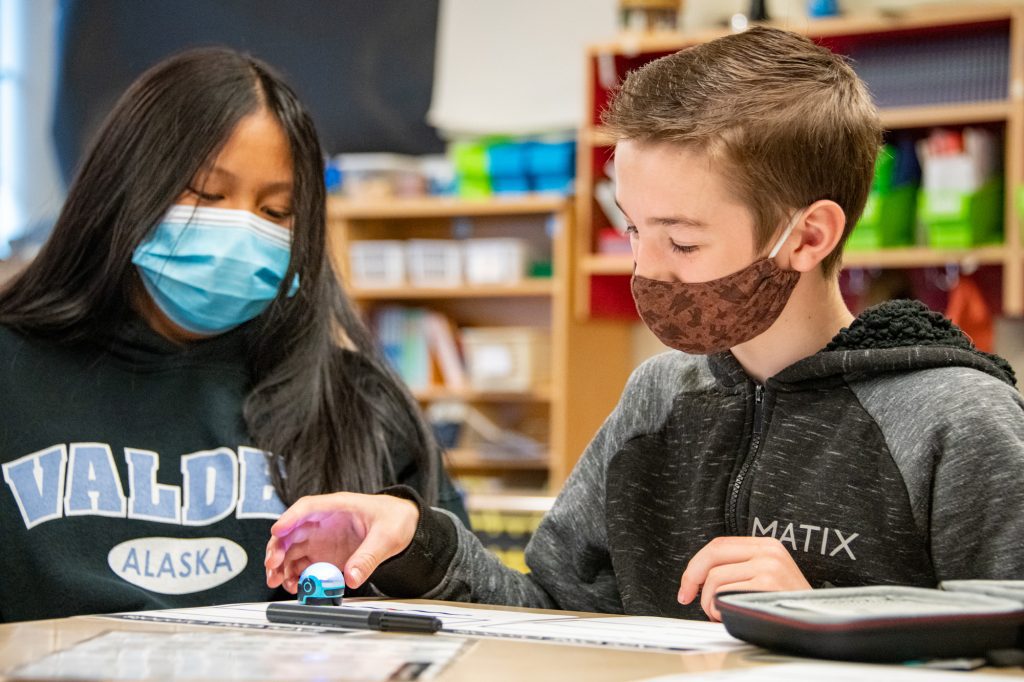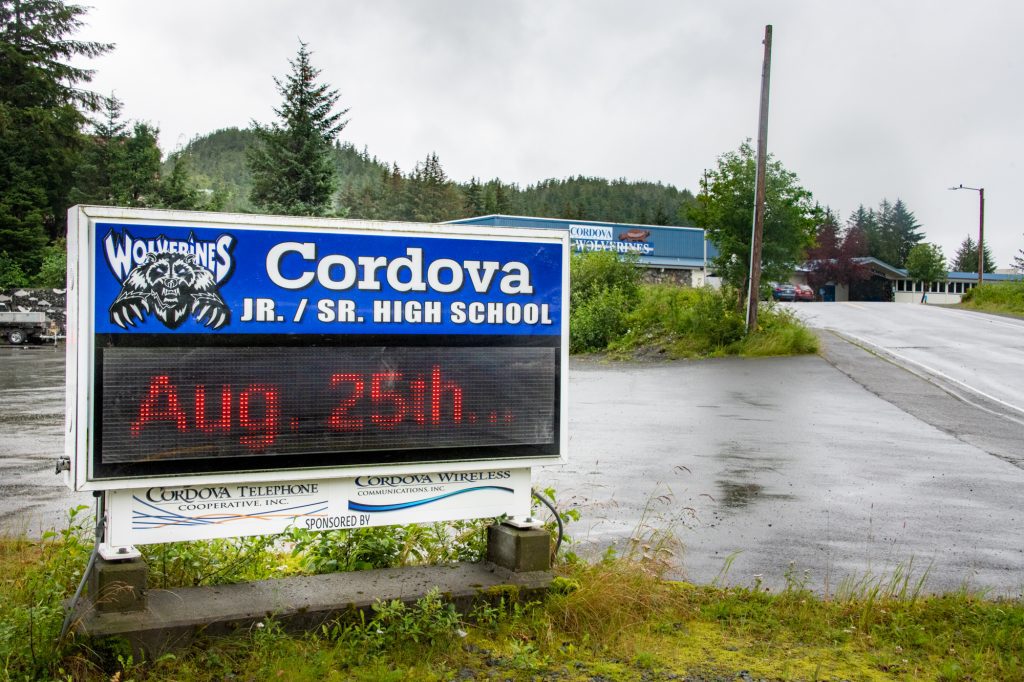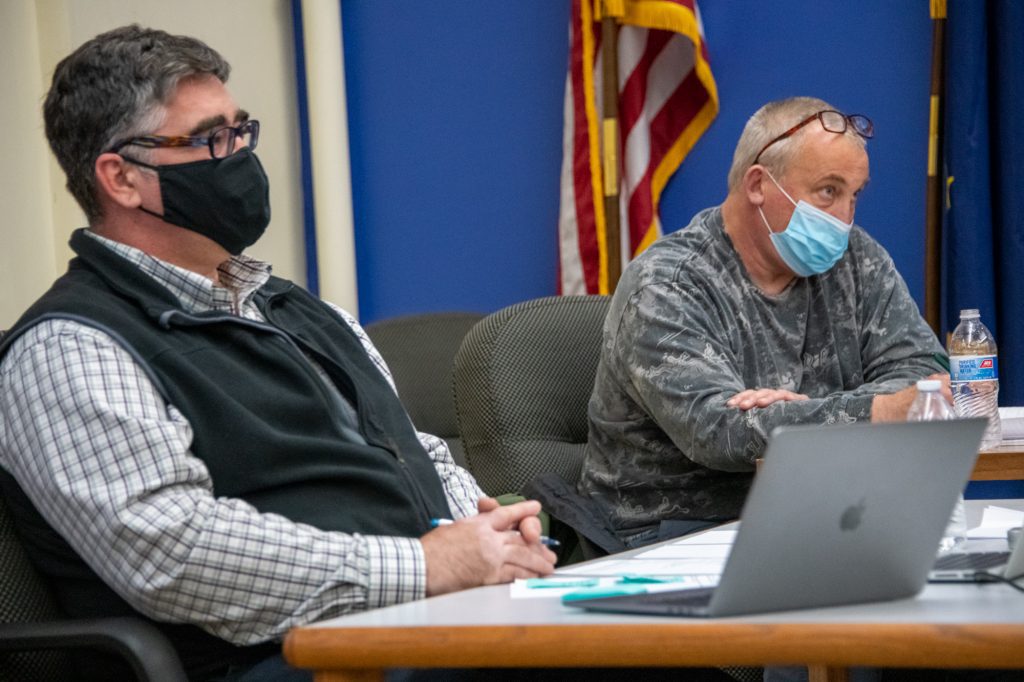
Classes at Cordova schools will resume Aug. 25, with students required to wear masks for much of the day. Students will attend a four-day school week, running Monday-Thursday from 8:40 a.m.-3:40 p.m. Fridays will be available for functions like staff and teacher training, parent-teacher conferences, and part-day student activities such as field trips and project work.
High COVID-19 infection rates make mandatory masking in schools a necessity, said Cordova Board of Education President Barb Jewell, who is also behavioral health program manager for the Sound Alternatives clinic at Cordova Community Medical Center. Jewell additionally cited the community’s low vaccination rate, which she described as under 50%.
“We can’t justify not having students wear masks right now,” Jewell said. “And I have to tell you, we were all pretty heartbroken because we were hours from saying, ‘Gosh, we might not have to have masks at school.’”
Over 160 virus cases have been reported since July 3, when Cordova’s current outbreak commenced, according to Alaska Department of Health and Social Services data. As the school year progresses, the district will monitor local conditions to determine the level of mitigation strategies needed for school operations, Superintendent Alex Russin said. There is concern that, without universal masking, students and staff will have to spend more time away from the classroom, since unmasked close contacts are required to quarantine when new virus cases are identified, Russin said.
It’s expected that students will not be required to wear masks nonstop while at school, removing them for snack and water breaks during class, for recess, for breakfast and lunch service, for restroom breaks and for periodic in-classroom “mask breaks,” Russin said.
“Other than masking, nearly all other things will look very much like school has in the past, and we want to keep it that way,” Russin wrote in an Aug. 9 public letter.
School administrators hope that, as the year proceeds, it will be possible to reduce protocols such as the wearing of masks, Russin said, though this will depend on local infection trends and on recommendations from health care professionals.
No cases of COVID-19 transmission have been traced to local school facilities. However, recently revised guidelines from the Centers for Disease Control and Prevention recommend universal indoor masking for teachers, staff and school visitors, as well as students age 2 and older, regardless of vaccination status. Although returning to in-person learning in fall 2021 is a high priority, the highly contagious coronavirus delta variant makes universal indoor masking advisable, CDC officials said. Other organizations that have endorsed masking in schools include the American Academy of Pediatrics.
If the school district did not require masking, it “would be going against every recommendation that’s been made for schools and students,” Jewell said.

‘Let the kids be normal’
Public response to the decision has been mixed, and some parents have declared that they will not enroll their children in school if a masking requirement is in effect.
Parents and kids should be responsible for deciding whether to mask up at school, said City Councilman David Allison, who is the parent of two elementary school students. Allison pointed out that wearing a mask does not guarantee to stop virus transmission, and said that wearing a mask can have negative effects for children. Allison also criticized the decision to limit regular classes to four days per week.
“Masks don’t stop this virus…and they cause socio-emotional issues, excess carbon dioxide from breathing your own exhaust, rashes, other physical issues, and for kids the inability to learn facial queues and pronunciation, etc.,” Allison wrote in an email. “There are way more issues from wearing masks than from COVID itself.” [ellipsis in original]
A series of studies endorsed by the CDC found that wearing a cloth or surgical mask had no effect on oxygen and carbon dioxide levels among healthy hospital workers, older adults and adults with chronic obstructive pulmonary disease. Further, a study of healthy, non-smoking adults published by the European Respiratory Journal found that mask use was safe even during exercise, though discomfort could occur. Even when wearing a mask, carbon dioxide escapes completely after being exhaled, the CDC reported.
A research letter published June 30 by JAMA Pediatrics, a journal of the American Medical Association, concluded that children who wore masks inhaled greater levels of carbon dioxide. However, July 16, JAMA Pediatrics retracted the research letter, citing concerns about methodology.
Though wearing a mask does not eliminate the chance of coronavirus transmission, various studies indicate that it can significantly diminish the chance of transmission. A study of 382 Navy servicemembers aboard the U.S.S. Theodore Roosevelt found that masking reduced the risk of virus infection by about 70%, even in an environment notable for its close working and living arrangements.
Kayley DeLozier, the parent of a Cordova first grader, acknowledged that there were legitimate concerns about the effects of not requiring masking. However, when DeLozier’s own family was quarantined after contracting COVID-19 as a result of her children being in daycare, she saw that many children who were infected showed little or no symptoms of the virus, she said.
“If we continue to cover [kids’] faces and deny them the opportunity of building their immune systems we are doing them a disservice,” DeLozier wrote in an email. “Not to mention the mental health aspects, abilities to learn, building of self esteem, connecting emotionally and much more… Between the vaccinated and people who have acquired natural immunities to it, it is seemingly a great time to let the kids be normal and not live in fear of something that has minimal effects on them. Adults can protect themselves. Children should not bear that responsibility.”
Many children who contract the coronavirus show no symptoms, and those that do get sick tend to experience relatively mild symptoms, such as a low fever, fatigue and cough, according to a Harvard Medical School report. However, some children infected with the virus develop a potentially dangerous complication termed multisystem inflammatory syndrome in children, or MIS-C. Symptoms of MIS-C include fever, rash, vomiting, diarrhea, swollen lymph nodes and bloodshot eyes.
A study published by the journal Lancet Child & Adolescent Health tracked the ongoing effects of MIS-C on 46 children who had been hospitalized with the syndrome. The study found that, six months after being discharged from hospital, most of the children had recovered without lasting organ damage. About one third of the children continued to experience physical and mental difficulties, though researchers could not determine whether this was due to MIS-C or other factors.
Though early studies indicated that children do not contribute much to the spread of the coronavirus, more recent research has thrown this conclusion into doubt. Children infected with the virus can have as much, or more, viral material in their upper respiratory tracts as infected adults, according to a Harvard Medical School report. Children carrying greater amounts of viral material also did not necessarily display more severe symptoms. This suggests, but does not prove, that children, including those without symptoms, could readily spread the infection to others, according to the report.
Other local critics of the school district’s decision included Republican Party Cordova Precinct leader William Deaton. Deaton, who was Cordova Jr./Sr. High School’s 2020 valedictorian, encouraged students to refuse to wear masks in a gesture of civil disobedience, but cautioned them not to “scoff, yell or pout,” or to make other displays of bad temper, while doing so.

‘It’s the least we can do’
The school district’s decision was applauded by high school student council member Mhikee Gasmen in an Aug. 9 email to educators. While young students may be able to handle COVID-19, the same can’t be said of older people, making masking a necessary measure to protect the community at large, Gasmen wrote. If Cordova students refused to wear masks, it would be humiliating to members of other communities who have no option but to attend online-only classes, she wrote.
“We have to protect our children and the school’s employees,” wrote Mary Cris and Herbert Carino, the parents of one high school sophomore and one first grader, in an email. “It’s the least we can do to help slow the spread of COVID-19. Not doing so would put our efforts as a community to protect our people in vain.”
Additional to masking, measures adopted by the school district include daily disinfecting of buildings with enhanced cleaning protocols when known virus cases have been present; using particle-trapping MERV-13 air filters; and limiting school access for unvaccinated non-essential visitors and volunteers.
“Any district decision that has an impact on the more than 350 students and staff that are in the building is rarely an easy decision,” Russin wrote in an email. “That said, we’re confident with the support of medical personnel… that universal masking to begin the year is an important mitigation strategy to continue.”





